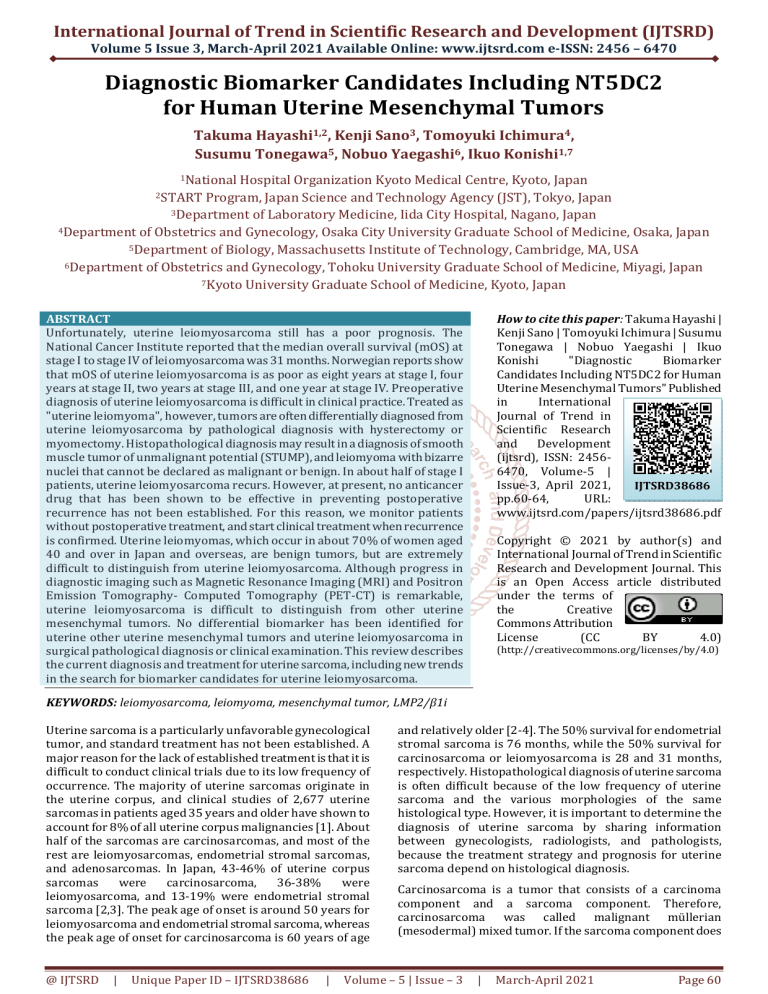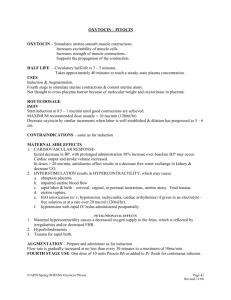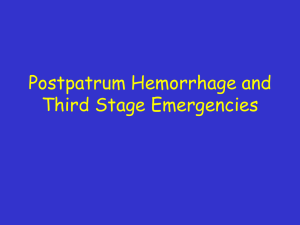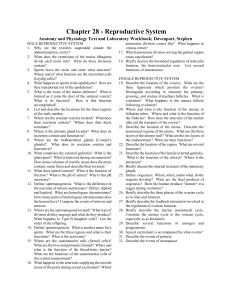
International Journal of Trend in Scientific Research and Development (IJTSRD)
Volume 5 Issue 3, March-April 2021 Available Online: www.ijtsrd.com e-ISSN: 2456 – 6470
Diagnostic Biomarker Candidates Including NT5DC2
for Human Uterine Mesenchymal Tumors
Takuma Hayashi1,2, Kenji Sano3, Tomoyuki Ichimura4,
Susumu Tonegawa5, Nobuo Yaegashi6, Ikuo Konishi1,7
1National
Hospital Organization Kyoto Medical Centre, Kyoto, Japan
Program, Japan Science and Technology Agency (JST), Tokyo, Japan
3Department of Laboratory Medicine, Iida City Hospital, Nagano, Japan
4Department of Obstetrics and Gynecology, Osaka City University Graduate School of Medicine, Osaka, Japan
5Department of Biology, Massachusetts Institute of Technology, Cambridge, MA, USA
6Department of Obstetrics and Gynecology, Tohoku University Graduate School of Medicine, Miyagi, Japan
7Kyoto University Graduate School of Medicine, Kyoto, Japan
2START
ABSTRACT
Unfortunately, uterine leiomyosarcoma still has a poor prognosis. The
National Cancer Institute reported that the median overall survival (mOS) at
stage I to stage IV of leiomyosarcoma was 31 months. Norwegian reports show
that mOS of uterine leiomyosarcoma is as poor as eight years at stage I, four
years at stage II, two years at stage III, and one year at stage IV. Preoperative
diagnosis of uterine leiomyosarcoma is difficult in clinical practice. Treated as
"uterine leiomyoma", however, tumors are often differentially diagnosed from
uterine leiomyosarcoma by pathological diagnosis with hysterectomy or
myomectomy. Histopathological diagnosis may result in a diagnosis of smooth
muscle tumor of unmalignant potential (STUMP), and leiomyoma with bizarre
nuclei that cannot be declared as malignant or benign. In about half of stage I
patients, uterine leiomyosarcoma recurs. However, at present, no anticancer
drug that has been shown to be effective in preventing postoperative
recurrence has not been established. For this reason, we monitor patients
without postoperative treatment, and start clinical treatment when recurrence
is confirmed. Uterine leiomyomas, which occur in about 70% of women aged
40 and over in Japan and overseas, are benign tumors, but are extremely
difficult to distinguish from uterine leiomyosarcoma. Although progress in
diagnostic imaging such as Magnetic Resonance Imaging (MRI) and Positron
Emission Tomography- Computed Tomography (PET-CT) is remarkable,
uterine leiomyosarcoma is difficult to distinguish from other uterine
mesenchymal tumors. No differential biomarker has been identified for
uterine other uterine mesenchymal tumors and uterine leiomyosarcoma in
surgical pathological diagnosis or clinical examination. This review describes
the current diagnosis and treatment for uterine sarcoma, including new trends
in the search for biomarker candidates for uterine leiomyosarcoma.
How to cite this paper: Takuma Hayashi |
Kenji Sano | Tomoyuki Ichimura | Susumu
Tonegawa | Nobuo Yaegashi | Ikuo
Konishi
"Diagnostic
Biomarker
Candidates Including NT5DC2 for Human
Uterine Mesenchymal Tumors" Published
in
International
Journal of Trend in
Scientific Research
and
Development
(ijtsrd), ISSN: 24566470, Volume-5 |
Issue-3, April 2021,
IJTSRD38686
pp.60-64,
URL:
www.ijtsrd.com/papers/ijtsrd38686.pdf
Copyright © 2021 by author(s) and
International Journal of Trend in Scientific
Research and Development Journal. This
is an Open Access article distributed
under the terms of
the
Creative
Commons Attribution
License
(CC
BY
4.0)
(http://creativecommons.org/licenses/by/4.0)
KEYWORDS: leiomyosarcoma, leiomyoma, mesenchymal tumor, LMP2/β1i
Uterine sarcoma is a particularly unfavorable gynecological
tumor, and standard treatment has not been established. A
major reason for the lack of established treatment is that it is
difficult to conduct clinical trials due to its low frequency of
occurrence. The majority of uterine sarcomas originate in
the uterine corpus, and clinical studies of 2,677 uterine
sarcomas in patients aged 35 years and older have shown to
account for 8% of all uterine corpus malignancies [1]. About
half of the sarcomas are carcinosarcomas, and most of the
rest are leiomyosarcomas, endometrial stromal sarcomas,
and adenosarcomas. In Japan, 43-46% of uterine corpus
sarcomas
were
carcinosarcoma,
36-38%
were
leiomyosarcoma, and 13-19% were endometrial stromal
sarcoma [2,3]. The peak age of onset is around 50 years for
leiomyosarcoma and endometrial stromal sarcoma, whereas
the peak age of onset for carcinosarcoma is 60 years of age
@ IJTSRD
|
Unique Paper ID – IJTSRD38686
|
and relatively older [2-4]. The 50% survival for endometrial
stromal sarcoma is 76 months, while the 50% survival for
carcinosarcoma or leiomyosarcoma is 28 and 31 months,
respectively. Histopathological diagnosis of uterine sarcoma
is often difficult because of the low frequency of uterine
sarcoma and the various morphologies of the same
histological type. However, it is important to determine the
diagnosis of uterine sarcoma by sharing information
between gynecologists, radiologists, and pathologists,
because the treatment strategy and prognosis for uterine
sarcoma depend on histological diagnosis.
Carcinosarcoma is a tumor that consists of a carcinoma
component and a sarcoma component. Therefore,
carcinosarcoma was called malignant müllerian
(mesodermal) mixed tumor. If the sarcoma component does
Volume – 5 | Issue – 3
|
March-April 2021
Page 60
International Journal of Trend in Scientific Research and Development (IJTSRD) @ www.ijtsrd.com eISSN: 2456-6470
not show a differentiation tendency, it is called homologous,
a sarcoma is called heterologous if it shows differentiation
into mesenchymal tissue that does not naturally exist in the
uterus, such as cartilage, striated muscle, and bone. In either
case, a polyp-like ridge that protrudes into the intrauterine
cavity is often formed macroscopically. Three theories have
been proposed for the histogenesis of uterine sarcoma:
combination tumor theory, collision tumor theory, and
composition tumor theory. Chronality analysis showed that
most of the carcinosarcomas were derived from single cells,
and showed that during tumor development, they
differentiated into epithelial-like and stromal-like
morphologies [5]. Clinicopathologic findings indicate that
carcinosarcoma is more like a carcinoma than a sarcoma,
based on findings such as common risk factors and many
lymphatic metastases. Therefore, surgery and postoperative
treatment for carcinosarcoma are in accordance with highgrade endometrial cancer.
For histopathological diagnosis of uterine leiomyosarcoma,
the diagnostic criteria proposed by the group of Hendrickson
and Kempson are widely used [6]. In other words, in the
diagnosis of uterine leiomyosarcoma, (1) cell atypia, (2)
fission (index), and (3) coagulation necrosis are
comprehensively evaluated. As the initial treatment for
uterine leiomyosarcoma, simple abdominal total
hysterectomy and bilateral adnexal excision may be the basic
treatments in cases that can be removed. There is no clear
evidence that extended surgery or additional lymph node
dissection improves prognosis. Phase III clinical trials have
provided no clear evidence of the efficacy of radiation or
chemotherapy as a postoperative treatment.
Endometrial stromal sarcomas were classified as low-grade
and high-grade. However, according to the current WHO
classification (2003), high-grade endometrial stromal
sarcoma does not necessarily have similarity to endometrial
stromal. Therefore, high-grade endometrial stromal sarcoma
is called undifferentiated endometrial sarcoma [7]. Like
leiomyosarcoma, treatment of endometrial stromal sarcoma
is based on simple abdominal total hysterectomy and
bilateral appendectomy. However, 9 to 33% of low-grade
endometrial stromal sarcomas and 15 to 18% of
undifferentiated endometrial sarcomas have metastases to
the pelvic or para-aortic lymph nodes, lymph node dissection
is required [8,9]. The efficacy of irradiation and
chemotherapy, regardless of grade, is unclear, so phase II
clinical trials will show the results of their therapeutic
effects. Since hormone receptors are positive in low-grade
endometrial stromal sarcoma, the efficacy of endocrine
therapy is also an important issue to be studied [10].
In collaboration with Professor Susumu Tonegawa
(Massachusetts Institute of Technology), Hayashi's group
reported that uterine leiomyosarcoma spontaneously
develops after 6 months of age in proteasome component,
low molecular mass polypeptide 2/β1i (LMP2/β1i)-deficient
female mice [11-13]. Hayashi et al. also demonstrated that
the incidence of uterine leiomyosarcoma up to 12 months of
age is approximately 37% of in all LMP2/β1i-deficient
female mice [11-13]. Therefore, in a joint study with a
collaborating medical institution, Hayashi et al. examined the
efficacy and reliability of LMP2/β1i as a biomarker for
uterine leiomyosarcoma. Hayashi et al. examined the
expression status of LMP2/β1i in 40 cases of normal
myometrium tissue, uterine leiomyoma tissue, and uterine
@ IJTSRD
|
Unique Paper ID – IJTSRD38686
|
leiomyosarcoma tissue obtained from the pathological file by
immunohistochemical staining using an anti-LMP2/β1i
antibody [14,15]. As a result, LMP2/β1i expression was
significantly reduced specifically in uterine leiomyosarcoma
tissue. Even in cases where differential diagnosis was
difficult with the current pathological diagnosis, it was easy
to distinguish between uterine leiomyosarcoma and uterine
leiomyoma based on the expression status of LMP2/β1i [14].
Currently, Hayashi et al. are collaborating with a
comprehensive reagent and diagnostics manufacturer to
examine a differential diagnosis method for uterine
leiomyosarcoma by immunohistochemical staining using a
combination of LMP2/β1i with other candidate cellular
factors; CAVEOLIN, CYCLIN B, CYCLIN E, Ki-67 (Table 1). As a
health and welfare activity of national and international
governments, uterine cancer screening (including uterine
leiomyoma with high incidence regardless of race) is
recommended for women aged 20 and over. Although serum
miRNAs with high diagnostic performance for preoperative
uterine mesenchymal tumor screening have been
investigated, there are still issues to be solved for the results
of this research to be practically applied in the clinical
practice.
In conclusion our investigation reviewed the current clinical
evidence comparing different adjuvant strategies for the
postoperative management of uterine-confined uterine
leiomyosarcoma patients. On the light of these data, it seems
that the administration of adjuvant chemotherapy does not
improve progression free survival of early stage uterine
leiomyosarcoma. Large prospective, randomized, multiinstitutional studies are needed to better assess the value of
different adjuvant strategies. Innovative target therapies
need to be tested in order to improve patients' outcome that
remains unsatisfactory. Defective expression of LMP2/β1i is
likely to be one of the risk factors for the development of
human uterine leiomyosarcoma, as it is in the LMP2/β1i
deficient mouse. Thus, combination of LMP2/β1i with other
functional candidates is useful for a novel diagnostic
biomarker
for
distinguishing
human
uterine
leiomyosarcoma from other mesenchymal tumors.
Additionally, gene therapy with LMP2/β1i expression
vectors may be a new treatment for human uterine
leiomyosarcoma that exhibit a defect in LMP2/β1i
expression. Because there is no effective therapy for
unresectable human uterine leiomyosarcoma, our results
may bring us to specific molecular therapies to treat this
malignant tumor.
5'-Nucleotidase Domain Containing 2 (NT5DC2) is a novel
oncoprotein, the regulatory effects of which have not been
well characterized. Our clinical facility has been investigating
the expression profile and functional regulation of NT5DC2
and its potential interplay in uterine leiomyosarcoma and
other uterine mesenchymal tumors. Our preliminary data to
date shows that NT5DC2 is aberrantly upregulated in human
uterine leiomyosarcoma. Overexpression of NT5DC2 was
associated with unfavorable survival. The artificial deficiency
of NT5DC2 significantly reduced the expression of cyclin B1,
cyclin A2, cyclin E1, and CDK1 and increased G1 phase arrest
in human uterine leiomyosarcoma cell lines and suppressed
their proliferation both in vitro and in vivo. Further studies
are required to investigate whether NT5DC2 can be a
biomarker for differentiating uterine leiomyosarcoma from
other mesenchymal tumors.
Volume – 5 | Issue – 3
|
March-April 2021
Page 61
International Journal of Trend in Scientific Research and Development (IJTSRD) @ www.ijtsrd.com eISSN: 2456-6470
Conclusion
Uterine leiomyosarcoma is a malignant tumor with a poor
prognosis that repeats recurrence and distant metastasis.
Preoperative diagnosis of uterine leiomyosarcoma is difficult
in clinical practice. Therefore, in order to distinguish uterine
leiomyosarcoma from other uterine mesenchymal tumors, it
is important to establish a simple diagnostic method using
biomarkers. Currently, clinical studies are being conducted
to verify the specificity and superiority of candidate cell
factors specific to uterine leiomyosarcoma as differential
biomarkers. We hope that a simple diagnostic method would
be established based on the results of future clinical studies.
Disclosure of potential conflicts of interest
The authors declare no potential conflicts of interest.
Ethical approval and consent to participate
This study was reviewed and approved by the Central Ethics
Review Board of the National Hospital Organization
Headquarters in Japan (Tokyo Japan). The authors attended
a 2020 educational lecture on medical ethics supervised by
the Japanese government. The completion numbers of the
authors are AP0000151756 AP0000151757 AP0000151769
AP000351128. This research is not clinical study, therefore
consent to participate is not required.
Research funding
This clinical research was performed with the support of the
following research funding: Japan Society for the Promotion
of Science for TH (grant No. 19K09840), START-program
Japan Science and Technology Agency (JST) for TH (grant No.
STSC20001), and National Hospital Organization Multicenter
clinical study for TH (grant No. 2019- Cancer in general-02).
Data availability and Consent to publish
This manuscript is an editorial and does not contain research
data. Therefore, there is no research data or information to
be published or opened.
Acknowledgements
We sincerely appreciate the generous donation of
PSMB9/β1i-deficient breeding mice and technical
comments by Dr. Luc Van Kaer, at Massachusetts Institute
of Technology. We thank Isamu Ishiwata for his generous
gift of the human Ut-LMS cell lines. We appreciate the
technical assistance of the research staff at Harvard
Medical School. We are grateful to Dr. Tamotsu Sudo and
Dr. Ryuichiro Nishimura, Hyogo Cancer Center for Adults
for their generous assistance with immunohistochemistry
(IHC) analysis and helpful discussion. Funding: This work
was supported by grants from the Ministry of Education,
Culture, Science and Technology (No. 15K10709), the
Japan Science and Technology Agency, the Foundation for
the Promotion of Cancer Research, Kanzawa Medical
Research Foundation, and The Ichiro Kanehara
Foundation.
Table 1 Classification of human uterine mesenchymal tumours
A.
Protein expression*
Mitotic
Tumor type Atypia
Necrosis Cy De CA SM Vi ER/P En EG Cy Cy LMP
activity
t s V A m
R
d F B E
2
Endometrial stromal tumors.
Endometrial
infreque
minimal
/inconspicuo + - ++ + + +++ + * + - ++
strimal nodule
nt
us
Endometrial
infreque
strimal
/inconspicuo
- ++ + + +++ + + + - -/+
nt
/+
sarcoma
us
Undifferentiat
Frequent
ed
marked (atypical
+
foc *
*
+ + + + -/+
endometrial
/+
MF)
sarcoma
Smooth muscle tumors
<5
Leiomyoma,
MF/10H
foc + ++ + * +++ -/+ -/+ + - ++
NOS
PF
Mitotically
>5
active
MF/10H
* + ++ + * +++ -/+ -/+ + - ++
leiomyoma
PF
Cellular
infreque
* + ++ + * +++ -/+ -/+ + - ++
leiomyoma
nt
Hemorrhagic
infreque
cellular
* + ++ + * +++ -/+ -/+ + - ++
nt
leiomyoma
<5
Epithelioid
MF/10H
* + ++ + * +++ -/+ -/+ * - ++
leiomyoma
PF
<5
Myxoid
MF/10H
* * *
*
*
* -/+ -/+ * + -/+
leiomyoma
PF
<10
Atypical
modera
MF/10H
- + ++ + * +++ + -/+ + + -/+
leiomyoma
te
PF
@ IJTSRD
|
Unique Paper ID – IJTSRD38686
|
Volume – 5 | Issue – 3
|
March-April 2021
Cliical
Ca Ki6
comments
l 7
++
-
Absence of
myometrial
infiltration
++ -/+
+
+
Lack specific
differentiati
on
Well++ -/+ circumscrib
ed
++ -/+
++ -/+
++ -/+
++ -/+
Pseudocaps
ul
Increased
cellularity
Hormone
induced
changes
Epitheliallike cells
+
+
Myxoid
material
/+
+
Separates
tumor cells
Page 62
International Journal of Trend in Scientific Research and Development (IJTSRD) @ www.ijtsrd.com eISSN: 2456-6470
infreque
*
nt
infreque
*
Lipoleiomyom
nt
a
>10
STUMP#
-/+
MF/10H +/uncertain *
Leiomyoma
PF
with bizarre
borderlin
nuclei
Marked
*
e
infreque +/difficult
*
nt
classify
>10
Leiomyosarco modera
MF/10H
+
+
ma
te
PF
-
+
++
+
*
+++
+
++
+
*
+
++
+
+
++
+
++
+
++ -/+
* -/+ *
+
-/+
* -/+
*
* -/+ * -/+ -/+
* -/+
*
*
* -/+ * -/+ -/+
* -/+
+
*
*
* -/+ * -/+ -/+
* -/+
+
*
*
* -/+ * -/+ -/+
* -/+
-
-
+ -/+ ++
-
-
-
-
-
-
++
+
Leiomyosarco
>5
modera
ma epitheliod
MF/10H
te
variant
PF
+
+
+
++ -/+
-
-
++
+ -/+ ++
+
Leiomyosarco
modera
ma myxoid
Any MF
te
variant
+
+
+
++ -/+
-
-
+ -/+ ++ ++
LANT#
absent frequent
+
Leiomyomatoid tumor
- - + + +
*
*
*insufficient data or not applicable
+
*
++
-
-
++
Scattered
adipocytes
Infiltrative
Infiltrative,
>50%
++
epithelioid
cells
Infiltrative,
myxoid
++
extracellular
matrix
-/+
NOTE1
Cyt.; cytokeratin, Des.; Desmin, CAV; caveolin 1 (ref.16), SMA; smooth muscle actin, Vim.; vimentin, ER/PR; estrogen
receptor/progesterone receptor, End.; Endoglin; CD105/TGFb receptor (stem cell marker), EGF, EGFR; epidermal growth
factor receptor, CyB; cyclin B1, CyE (ref.17); cyclin E, LMP2; low molecular mass polypeptide 2, Cal.; calponin h1, CD56; neural
cell adhesion molecule (N-CAM), WT-1; wilms tumor 1, NOS; not otherwise specified, MF; magnification factor, HPF; high power
field, Foc.; focal, STUMP; smooth muscle tumours of uncertain malignant potential. Protein expression*, estimated-protein
expressions by immunoblot analysis, immunohistochemistry (IHC) and/or RT-PCR (quantitative-PCR), +/-; partial expression,
+; expression, ++; medium expression, +++; high expression, -; no evidence of expression, ER/PR, PSMB9, cyclin E, calponin h1,
Ki-67 (ref.18). STUMP#. Cyclin E, PSMB9, calponin h1 are potential biomarker for human uterine mesenchymal tumours.
LANT#, leiomyomatoid angiomatous neuroendocrin tumour (LANT) is described as a dimorphic neurosecretory tumour with a
leiomyomatous vascular component (ref.19). NOTE1, Low-grade neuroendocrine tumour possibly related to null cell adenoma.
References
[1] Brook, S. E., Zhan, M., Cote, T., Baquet, C. R., 2004,
Surveillance, epidemiology, and end results analysis of
2, 677 cases of uterine sarcoma 1989-1999. Gynecol
Oncol 93, 204-208. [PMID: 15047237]
[2]
[3]
[4]
[5]
Ricci, S., Stone, R. L., Fader, A. N., 2017, Uterine
leiomyosarcoma: Epidemiology, contemporary
treatment strategies and the impact of uterine
morcellation. Gynecol Oncol. 145(1), 208-216. [PMID:
28209496]
Sagae S, Yamashita K, Ishioka S, Nishioka Y, Terasawa
K, Mori M, Yamashiro, K., Kanemoto, T., Kudo, R., 2004,
Preoperative diagnosi and treatment results in 106
patients with uterine sarcoma in Hokkaido, Japan.
Oncology 67, 33-39. [PMID: 15459493]
Akahira, J., Tokunaga, H., Toyoshima, M., Takano, T.,
Nagase, S., Yoshinaga, K., Tase, T., Wada Y., Ito, K.,
Niikura, H., Yamada, H., Sato, A., Sasano, H., Yaegashi,
N., 2006, Prognoses and prognostic factors of
carcinosarcoma, endometrial stromal sarcoma and
uterine leiomyosarcoma a comparison with uterine
endometrial adenocarcinoma. Oncology 71, 333-340.
[PMID: 17690557]
Wada, H., Enomoto, T., Fujita, M., Yoshino, K.,
Nakashima, R., Kurachi, H., Haba, T., Wakasa, K.,
Shroyer, K. R., Tsujimoto, T., Hongyo, T., Nomura, T.,
Murata, Y., 1997, Molecular evidence that most but
@ IJTSRD
|
Unique Paper ID – IJTSRD38686
|
not all carcinosarcomas of the uterus are combination
tumors. Cancer Res 57, 5379-5385. [PMID: 9393763]
[6]
Bell, S. W., Kempson, R. L., Hendrickson, M. R.,
1994, Problematic uterine smooth muscle
neoplasms. a clinicopathologic study of 213 cases.
Am J Surg Pathol 18, 535-558. [PMID: 8179071]
[7]
Hendrickson, M. R., Tavassoli, F. A., Kempson, R.
L., McCluggage, W. G., Haller, U., Kubik- Huch, R.
A., 2003, Mesenchymal tumours and related
lesions. In: Tavassoli FA, Devilee P, eds. World
Health Organization Classification of Tumours.
Pathology & Genetics. Tumours of the Breast and
Female Genital Organs. Lyon: IARC Press, 233- 244.
[8]
Leath, C. A. 3rd, Huh, W. K., Hyde, J. Jr., Cohn, D. E.,
Resnick, K. E., Taylor, N. P., Powell, M. A., Mutch, D. G.,
Bradley, W. H., Geller, M. A., Argenta, P. A., Gold, M. A.,
2007, A multi-institutional review of outcomes of
endometrial stromal sarcoma. Gynecol Oncol 105,
630-634. [PMID: 17320937]
[9]
Riopel, J., Plante, M., Renaud, M. C., Roy, M., Tetu,
B., 2005, Lymph node metastases in low- grade
endometrial stromal sarcoma. Gynecol Oncol 96, 402406. [PMID: 15661228]
[10]
Zang, Y., Dong, M., Zhang, K., Gao, C., Guo, F., Wang, Y.,
Xue, F., 2019, Hormonal therapy in uterine sarcomas.
Cancer Med. 8(4), 1339-1349. [PMID: 30897294]
Volume – 5 | Issue – 3
|
March-April 2021
Page 63
International Journal of Trend in Scientific Research and Development (IJTSRD) @ www.ijtsrd.com eISSN: 2456-6470
[11]
Hayashi, T., Kodama, S., Faustman, D. L., 2000, Reply
to 'LMP2 expression and proteasome activity in NOD
mice' Nat Med. 6(10), 1065-1066. [PMID: 11017113]
[12]
Hayashi, T., Faustman, D. L., 2002, Development of
spontaneous uterine tumors in low molecular mass
polypeptide-2 knockout mice. Cancer Res. 62(1), 2427. [PMID: 11782352]
[13]
Hayashi, T., Horiuchi, A., Sano, K., Hiraoka, N., Kasai,
M., Ichimura, T., Sudo, T., Tagawa, Y., Nishimura, R.,
Ishiko, O., Kanai, Y., Yaegashi, N., Aburatani, H.,
Shiozawa, T., Konishi, I., 2011, Potential role of LMP2
as tumor-suppressor defines new targets for uterine
leiomyosarcoma therapy. Sci Rep. 2011; 1: 180. doi:
10. 1038/srep00180. [PMID: 22355695]
[14]
[15]
Hayashi, T., Horiuchi, A., Aburatani, H., Ishiko, O.,
Yaegashi, N., Kanai, Y., Zharhary, D., Shiozawa, T.,
Tonegawa, S., Konishi, I., 2014, Potential biomarker
for human uterine leiomyosarcoma. J Clin Med Res.
6(5), 392-394. [PMID: 25110546]
Hayashi, T., Kawano, M., Sano, K., Ichimura, T., Gur, G.,
Yaish, P., Zharhary, D., Kanai, Y., Tonegawa, S.,
Shiozawa, T., Yaegashi, N., Konishi, I., 2017, A novel
diagnostic
biomarker
for
human
uterine
leiomyosarcoma: PSMB9/β1i. Chin Clin Oncol. 6(2),
@ IJTSRD
|
Unique Paper ID – IJTSRD38686
|
22. doi: 10. 21037/cco. 2017. 04. 03. [PMID:
28482675]
[16]
Hayashi, T., Ichimura, T., Yaegashi, N., Shiozawa, T.,
Konishi, I., Expression of CAVEOLIN 1 in uterine
mesenchymal tumors: No relationship between
malignancy and CAVEOLIN 1 expression. Biochem
Biophys Res Commun. 2015 Aug 7; 463(4): 982-7.
doi: 10. 1016/j. bbrc. 2015. 06. 046.
[17]
Patent: Detection of uterine leiomyosarcoma using
LMP2.
Application
JP2007548042A
events.
https://upload.umin.ac.jp/cgi-openbin/ctr/ctr_view.cgi?recptno=R000044182
[18]
Matsuda, M., Ichimura, T., Kasai, M., Murakami, M.,
Kawamura, N., Hayashi, T., Sumi, T., Preoperative
diagnosis of usual leiomyoma, atypical leiomyoma,
and leiomyosarcoma. Sarcoma. 2014; 2014: 498682.
doi: 10. 1155/2014/498682. Epub 2014 Oct 21.
[19]
Hayashi, T., Ichimura, T., Kasai, M., Sano, K., Zharhary,
D., Shiozawa, T., Yaegashi, N., Konishi, I.,
Characterization of Leiomyomatoid Angiomatous
Neuroendocrine Tumour (LANT)-like Tumour in the
Myometrium with Histopathological Examination.
Anticancer Res. 2017 Apr; 37(4): 1765-1772. doi: 10.
21873/anticanres. 11509.
Volume – 5 | Issue – 3
|
March-April 2021
Page 64






